
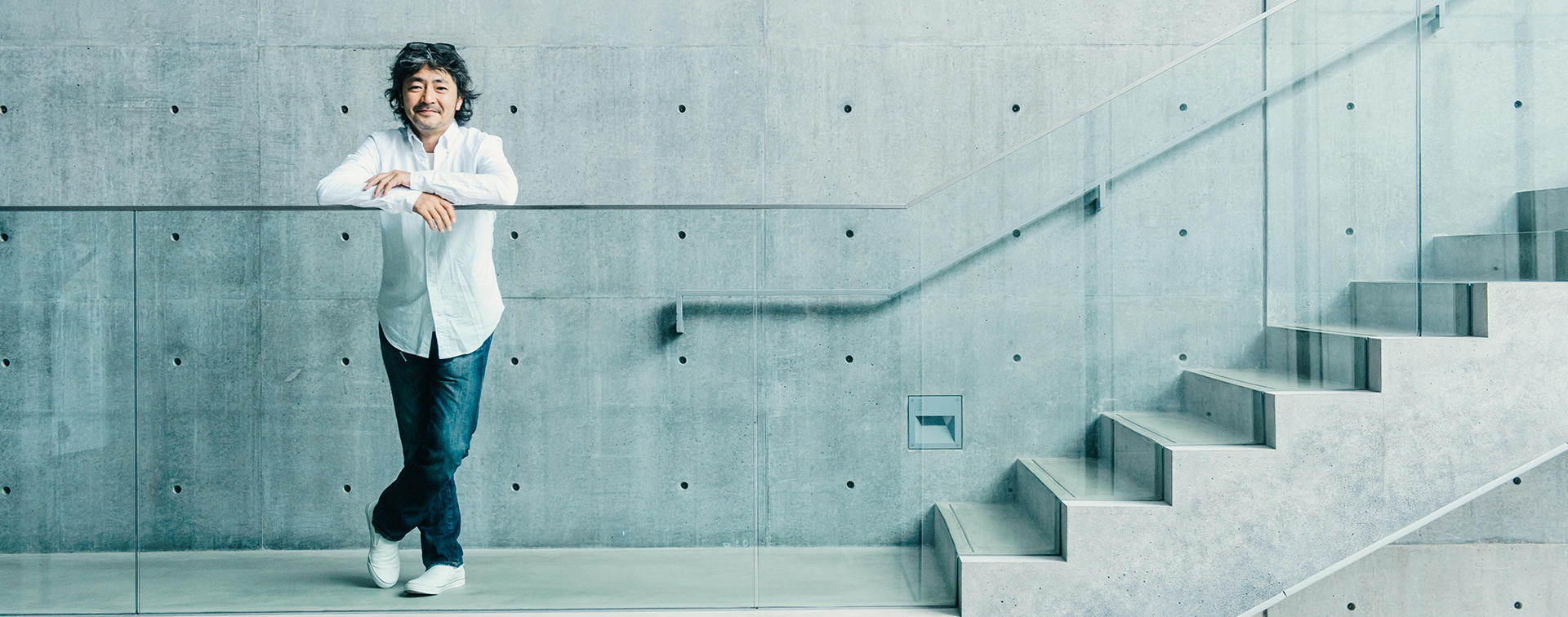

Presenting Roppongi as a place for dating
An open air movie theater and romantic movie
Seiichi Hishikawa, a creator whose activities are watched both in Japan and abroad, oversaw the "Motion Science" exhibition that started June 19 at 21_21 DESIGN SIGHT. Hishikawa directed the "xylophone" TV commercial for NTT Docomo which won three awards at the Cannes Lions International Advertising Festival, the world's largest advertising award. In this interview, we asked Hishikawa about the "Motion Science" exhibition, projects he would like to do in Roppongi, and the future of motion design.
A baby-making campaign by designer and creators
This might be a dull thing to say, but the thing that alarms me right now is the decline in the number of children. I teach at university, so it's very palpable to me that students taking entrance exams are getting fewer. And the figures show that there will be no increase in the future.
Sometimes, when people plan events that are a bit erotic, they say half-jokingly that the aim is to alleviate "shoshika" (trend toward having fewer children). I think such events should be held in a more earnest, wholehearted way. When I heard that for this interview, you wanted me to talk about the future, the first thing I immediately thought of was to get together designers and creators and launch something like a baby-making campaign.
Compared to Japan, countries like America and France have open attitudes toward matters such as erotic depiction and sexuality. And when it comes to courtship, they can become very passionate. We need to think about how we can ignite the same "nikushoku-kei" (carnivore type) energy in the Japanese. I've recently become involved in a project in Tokushima and I was told that the birthdays of many people in Tokushima are in June. Apparently the reason for this is the Awa Odori Dance Festival in August. The women wearing the "hanagasa" (straw hats with flowers) all look beautiful, and their movements are graceful, and the men, understandably, become totally captivated. (laughs) I don't know whether the rumor is true but it does seem to explain it.
Cheerful events themed on love and eroticism
From my perspective as a filmmaker, the "Kanazawa Film Festival" is an event I find interesting: it's been held by a group of people since 2007. In 2012, the theme was "eroticism." Among the works shown was the anime film "Lupin the Third" in which Hayao Miyazaki-san drew the character Fujiko Mine completely naked for the first and last time. The movie "Emmanuelle" was also shown. The works selected were not pornographic but were comedies or love stories with a touch of eroticism and the event had a considerably cheerful atmosphere. But at overseas film festivals such as in London or Shanghai, movies forbidden for people under 18 are shown during the evening.
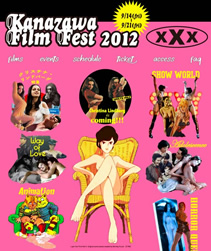
Kanazawa Film Festival
An annual film festival held from August to September in Kanazawa, Ishikawa Prefecture. Started in 2007, the event is sponsored by a group of movie enthusiasts called "Kanazawa eiganokai". Movie showings and symposiums are held on various themes, drawing around 3,000 visitors.
This is just an impression I have, but Roppongi seems to be a place where showing such movies would be permissible. (laughs) Roppongi has its daytime face and nighttime face. Its modern, sophisticated side co-exists in harmony with its seedy side. I don't think there are many places like that. If its seedy side was eliminated, Roppongi would become increasingly like Odaiba. And if its sophisticated side was taken away, that would be problematic for its future as well. The existence of both sides creates a good balance.
Talking about these things easily invites criticism of lewdness and indecency. However, faced with the reality of fewer babies being born, I think we need to make a full-fledged effort. We ought to present romance and love and sex in a more cheerful and healthy way. It would be an opportunity for designers and creators to show their talents.
Quietly preparing the stage for couples
Put bluntly, the aim of all this is "baby-making" but we can quietly prepare Roppongi as the stage for the part that comes before that. We can let people know about the nice hotels here and set a romantic mood for Christmas which couples look forward to so much. We could recreate the mood of the '80s and '90s bubble economy and the "trendy dramas" of that period and make Roppongi a place where people can fall in love in a wholesome way.
I've always been telling people that if I were to make a movie, it would be a romance. Of course, I have ideas for the movie itself, but I have a desire to have couples come and see it. I want them to watch my movie in a movie theater on a date. Maybe watching movies on a date is regarded as being bland these days, but I wish I could restore the status of the movie theater as the classic destination for a date.
Of course, it would be good to encourage couples to go to the movie theaters in Roppongi, but even better would be an open air theater. When I was traveling by myself in California, I was moved to find out that drive-in movie theaters still exist. It's so refreshing to watch movies and listen to music out in the open. It would be nice if a gigantic screen could be set up on the lawn of Tokyo Midtown - we could do without the space for cars. (Editor's note: In 2008, an open air event called "Garden Theater Café was held at Tokyo Midtown.)
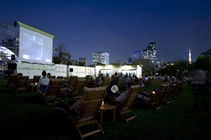
Garden Theater Café
An event held July 18 -Aug. 24, 2008 on the Grass Square at Tokyo Midtown. From dusk to nightfall, open air cafes served meals made with fresh vegetables delivered directly from the farms. At night, visitors enjoyed watching a movie in an open air theater.

A place that has both izakaya and design-related establishments
For a two-year period from 1998 to 1999, the office of my company Drawing and Manual was located just behind the AXIS building. I moved there for the banal reason that Starbucks was nearby. At that time, there were very few Starbucks stores in Japan. I thought, "Roppongi seems to be the right place - it has Starbucks and AXIS." (laughs) As I told you earlier, Roppongi has its nighttime face and daytime face, and I chose Roppongi because it has many design-related establishments as well as bars and izakaya (Japanese bars offering drinks and food) and there aren't many towns that have both.
During that period, the three of us - Tokujin Yoshioka-san and Kenmei Nagaoka-san and I - held the "Motion Graphics" exhibition every year at the AXIS gallery. It was a time when companies like Adobe and Apple had just entered the genre of animated graphics and the term "motion graphics", which is commonly used now, was not understood at all. A person from Adobe even came to us to ask for permission to use the word "motion graphics" for the subtitle of its software.
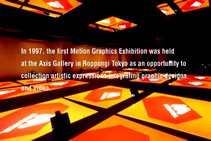
"Motion Graphics" exhibition
Held annually from 1997 to 2000 at the AXIS Gallery in Roppongi, Osaka and other places. Showed animated works employing two-dimensional designs such as corporate logos and onomatopoeic words used in manga. The exhibition was a precursor of the motion graphics movement.
So Roppongi is a place I have many memories of. Some of my favorite restaurants are here. One of them is "Keyaki Kurosawa" which I often still go to when I want to have deep conversations with friends. Of course the food is good, but I'm drawn to the fact that the restaurant is themed on the dining table of movie director Kurosawa.
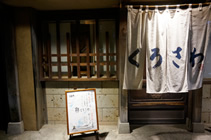
Keyaki Kurosawa
A restaurant on Tele-Asa Dori street serving traditional Japanese cuisine such as handmade soba noodles. The restaurant's interior and menu are themed on the kitchen and food preferences of filmmaker Akira Kurosawa. Posters of Kurosawa movies adorn the walls. A sister restaurant "Udon Kurosawa" is located at the back of TSUTAYA TOKYO ROPPONGI.
The future depicted in movies has yet to be realized
The exhibition that I'm directing at the 21_21 DESIGN SIGHT is themed not on motion graphics, but motion science. I decided on this theme because while codes (programs) are what currently move things, I feel that the next innovation will be in mechanism. Mechanism is about how a door opens or the way a chair is pulled in and out.
Occasionally, I see movies on YouTube showing doors that open in innovative ways, but those are about the only examples I see. The evolution of mechanism is slow. Designers are working hard every day, competing to come up with better designs which do not infringe patents. However, the designs are only different in the tiny details - the shape of something might be just a little bit slender than before, or it may be based on ergonomics. I think more advances would be possible by incorporating new materials and new technology. I've always felt that we need a dramatic change in the way we think.
This might be an extreme example, but we still haven't managed to make the "Anywhere Door" yet, have we? (laughs) Advances have been made in programs and academic skills, but not in the area of product making.
The future depicted in movies like "2001: A Space Odyssey" and "Back to the Future" is already here, and we've been living in this age for some time now, but a lot of the things that were predicted in those movies have not yet been realized.
Letting children see the mechanism of things
Perhaps I'm interested in the movement and mechanism of things because my father used to work in a factory. We no longer have factories in the streets, so children nowadays grow up without seeing how machines make products. The children only know that things are somehow manufactured in large, white buildings that look like research facilities, and all they see are the finished products. I suppose it can't be helped because corporations have secrets to keep.
Nowadays, when you want to open the car window, you just push a button and the glass pane automatically goes down. But in the past, you had to turn the handle round and round. The window opened with the turn of the handle, and it was easy to understand the mechanism. Today though, it's difficult to understand what kind of system is making the window open. It's the same with the smart phone. The majority of people are vaguely aware that something amazing is going on inside their smart phones but they leave it at that.
With the mechanism of so many products hidden from view, how can children find things that arouse their interest? To all the big Japanese manufacturers like Sony and Panasonic, I really feel like saying, "Sorry to be a nuisance, but for the sake of the children's future, please reveal all your secrets!" (laughs)
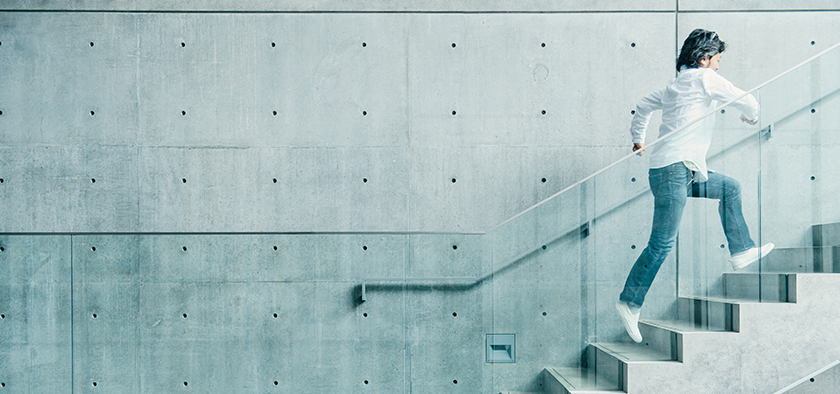
Leaving spaces to allow for imagination
At the "Motion Science" exhibition, I wanted to show an exciting vision of the future - of the kind depicted in anime like "Doraemon" and in magazines and movies. We've collected things which incorporate technology but which at first glance do not look digitalized; they move according to principles and rules which we can understand. We have given as much explanation as possible on how they work.

"Motion Science" exhibition
Showing items ranging from a replica of world's first car run on gasoline to a white balloon sent floating upward by wind, the exhibition invites visitors to experience and contemplate the mechanism and visual appeal of moving products, the fun of making things, and the relationship between design and developments in science and technology. Seiichi Hishikawa directed the exhibition. Held June 19 - Sept. 27 at 21_21 DESIGN SIGHT.
The catch phrase for the exhibition is "no black boxes." I asked all the creators to avoid making things which make viewers think, "It looks awesome but I have no clue about its internal mechanism." I told them that I want the visitors to understand all that they see. The ideal is to have an environment where children can freely look at everything and then focus on the things that ignite their curiosity. I hope that by coming to this exhibition, more children will be inspired to become people who design or make things.
Nowadays, the future is depicted in such intricate detail. For example, in the movie "Transformers: Age of Extinction", the future was very realistically depicted and it was stunning, but as to whether the future looked like fun, well.... I think magazines in the past depicted a future that looked a lot more fun, showing illustrations of cars flying in the sky for instance. I guess that was because space was left to allow for the reader to use his own imagination. Incidentally, the "Motion Science" exhibition is also full of spaces and it might frustrate people with good knowledge of the things on display. A science student might say, "Actually there is another type of technology that is not described here..." and give a long explanation. (laughs) When creating the spaces, I was half-hoping that they would prompt that kind of response from visitors as well.
A common language for motion graphics
Lastly, I'd like to talk a little bit about something that concerns the future of motion design. If I were to participate in a conference on design, I would propose creating a common language for motion design. There are fonts in graphic design and I think we should have the same thing in motion design, having, for example, names for 100 different motions. Disney has 12 rules on animation; there are rules on movements such as when something stops or jumps. We ought to make something similar.
Graphic designers all over the world understand what "Helvetica bold" refers to. We ought to have a common language for motion design just like there is one for graphic design so that if someone says, "swipe, slightly fast" the response would be, "Ah, right."
It would also be good to have preset software with a wide selection of different motions, just like there is software with preset fonts. With one touch of a key, you could instantly get a "biyoyoyooon" motion. By having each of those motions properly categorized, I think further advances will become possible. The popularity of types and fonts led to the emergence of typographers or type designers. I think that if we leave things in the muddled state they are in now, the genre of motion graphics will become even more confusing in the future.
"Biyoon" might come to be used worldwide
When making motion graphics, we currently rely entirely on imitative sounds. So in the workplace there are mature adults saying "biyoon" and "a little more boiiin" to each other with serious expressions on their faces. (laughs) Japan has unique imitative sounds. In American cartoons too, there are some imitative sounds like "bong" and "grrr", but the onomatopoeia is not as rich as in Japan. That is precisely why I'm hoping that a company like Adobe would gather together all the motion designers in the world and set up rules.
Some people might feel that if the motions were given names, we might not be able to say "biyoon" anymore. But who knows? Maybe the motion we now call "biyoon" might formally come to be known worldwide as "biyoon." Perhaps it will be explained that it came from Japanese onomatopoeia. (laughs) That would be interesting, wouldn't it?
Editor's thoughts
Hishikawa-san told us that his favorite cities are San Francisco, Milan, Sapporo, Hiroshima, Nagasaki and Matsuyama. They all have one thing in common - tram trains. "Tram trains may not be very efficient, but I feel that places with tram trains have a sound philosophy regarding town development, and have an understanding of values such as tourism value," he said. I think he has a point.(edit_kentaro inoue)



















